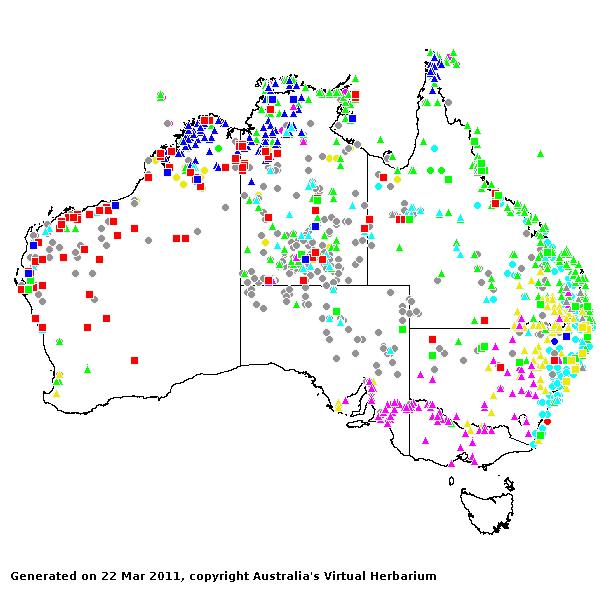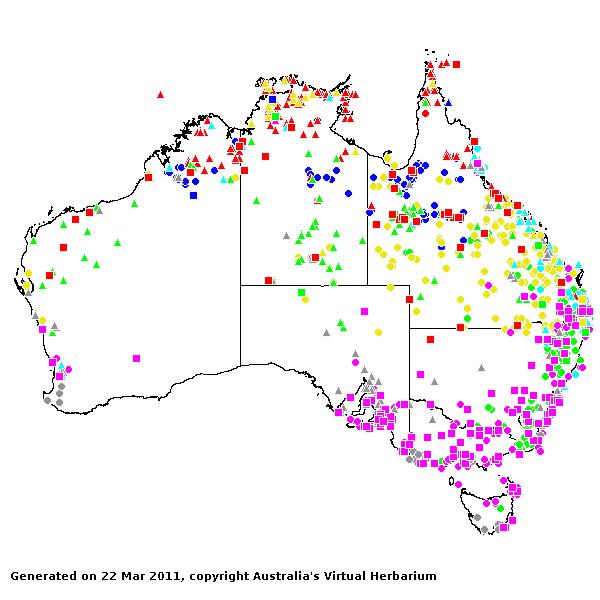Cenchrus Sp. Pl. 1049 (1753).
Derivation:. From Greek kenchros (millet).
Taxonomic revisions, nomenclatural references:. D.G.De Lisle, Iowa J. Sci. 37: 259–351 (1963).
Key references (keys and floras):. G.Bentham, Flora Australiensis 7: 496–498 (1878); C.A.Gardner, Flora of Western Australia 1 Gramineae 283–288 (1952); J.W.Vickery, Flora of New South Wales, Gramineae 19: 253–263 (1975); E.E.Henty, Manual Grasses New Guinea 46–47 (1969); M.Lazarides, Tropical Grasses S.E. Asia 109–110 (1980); M.Lazarides, Flora of Central Australia 479–480 (1981); J.C.Tothill and J.B.Hacker, Grasses of Southern Queensland 148–150 (1983); J.P.Jessop, Flora of South Australia 4: 1960–1962 (1986); R.D.Webster, Australian Paniceae 18–28 (1987); T.D.Macfarlane, Flora of the Kimberley Region 1133, 1135–1136 (1992); B.K.Simon, Key to Australian Grasses 83 (1993); S.W.L.Jacobs and S.M.Hastings, Flora of New South Wales 4: 500–503 (1993); N.G. Walsh, Flora of Victoria 2: 614–617 (1994); E.Edgar and H.E.Connor, Flora of New Zealand 5: 537–539 (2000); D.Sharp and B.K.Simon, AusGrass (2002); J.P.Jessop, Grasses of South Australia 431–437 (2006); S.W.L.Jacobs, R.D.B.Whalley & D.J.B.Wheeler, Grasses of New South Wales, 4th Ed, 178–182 (2008).
W.D.Clayton & S.A.Renvoize, Genera Graminum (1986), genus (534).
Native and naturalised. 22 species, from tropical and warm temperate regions. 11 species in Australia, WA, NT, SA, Qld, NSW, and Vic. Also New Guinea, Malesia and New Zealand.
Habit. Annual or perennial, rhizomatous or stoloniferous or tufted or decumbent. Leaf blades narrow. Ligule a fringed membrane to a fringe of hairs.
Inflorescence. Inflorescence a false spike, with spikelets on contracted axes (the spikelets in prickly glomerules (burrs) composed of coalescing spines representing modified branchlets), a spike-like panicle. Spikelet-bearing axes much reduced (to burrs, consisting of 1–8 spikelets surrounded by an involucre of flexuous or spiny bristles united to varying degrees), falling entire (the burrs falling).
Spikelets. Spikelets dorsally compressed, 2 flowered, with 1 fertile floret, with involucres of bristles (the bristles coalescing, by contrast with Pennisetum), solitary. Fertile spikelets with lower incomplete floret(s), lanceolate or ovate, falling with glumes (i.e., in the burrs).
Glumes. Glumes unequal, shorter than adjacent lemmas or long relative to adjacent lemmas, awnless, dissimilar or similar (hyaline or membranous). Lower glume 1–5 nerved. Upper glume 1–7 nerved.
Florets. Lower incomplete floret(s) male, or sterile. Lemmas awnless, 1–7 nerved, more or less equalling fertile lemmas, less firm than fertile lemmas, not becoming indurated. Fertile florets 1. Lemmas similar in texture to glumes to decidedly firmer than glumes (firmly membranous, dull, papery or leathery), smooth, not becoming indurated, yellow in fruit, entire at apex, muticous, with a clear germination flap, 3–7 nerved, glabrous, having flat margins not tucked into palea. Palea relatively long, entire, textured like lemma, 2 nerved. Lodicules 0. Stamens 3. Grain small, compressed dorsiventrally. Hilum short. Embryo large.
Kranz Anatomy. C4, biochemical type NADP-ME (C. pauciflorus, C. incertus).
2n = 34, 35, 36, 40, 44, 45, and 68, commonly adventive.
Habitat. Mesophytic to xerophytic. Grassland, bush, sandy and weedy places. Shade species, or species of open habitats.
Classification. Panicoideae; Paniceae.
Notes. The genus can usually be recognised by its prickly burrs, but it approaches closely to Pennisetum, especially P. basedowii and P. ramosum in which the bristles are somehat flattened (Clayton and Renvoize, 1986).
Types Species. C. echinatus L.
Biogeographic Element. Clifford & Simon 1981, Simon & Jacobs 1990: Gondwanan.
Pennisetum Syn. Pl. 1: 72 (1805). = Cenchrus
Derivation:. From Latin penna (feather) and seta (bristle), referring to the long feathery bristles in the spikelets.
Key references (keys and floras):. G.Bentham, Flora Australiensis 7: 495–496 (1878); C.A.Gardner, Flora of Western Australia 1 Gramineae 276–283 (1952); E.E.Henty, Manual Grasses New Guinea 146–147 (1969); J.W.Vickery, Flora of New South Wales, Gramineae 19: 241–253 (1975); M.Lazarides, Tropical Grasses S.E. Asia 134–136 (1980); J.C.Tothill and J.B.Hacker, Grasses of Southern Queensland 336–338 (1983); J.P.Jessop, Flora of South Australia 4: 1973–1974 (1986); R.D.Webster, Australian Paniceae 182–194 (1987); T.D.Macfarlane, Flora of the Kimberley Region 1203–1204 (1992); B.K.Simon, Key to Australian Grasses 142–143 (1993); S.W.L.Jacobs and S.M.Hastings, Flora of New South Wales 4: 497–500 (1993); N.G.Walsh, Flora of Victoria 2: 611–614 (1994); D.I.Morris, Student's Flora of Tasmania 4B: 347–351 (1994); E.Edgar and H.E.Connor, Flora of New Zealand 5: 571–580 (2000); D.Sharp and B.K.Simon, AusGrass (2002); J.P.Jessop, Grasses of South Australia 470–474 (2006); S.W.L.Jacobs, R.D.B.Whalley & D.J.B.Wheeler, Grasses of New South Wales, 4th ed, 331–334 (2008).
W.D.Clayton & S.A.Renvoize, Genera Graminum (1986), genus (533).
Native and naturalised. About 80 species, from
warm regions. 11 species in Australia, WA, NT, SA, Qld, NSW, Vic, and
Tas. Also New Guinea, Malesia and New Zealand.
Habit. Annual (rarely) or
perennial, stoloniferous or tufted or decumbent. Leaf blades broad or
narrow. Ligule a fringed membrane to a fringe of hairs. Hidden
cleistogenes when present, in leaf sheaths.
Inflorescence. Inflorescence a
false spike, with spikelets on contracted axes or paniculate (the
spikelets fascicled in false spikes, in small groups or apparently
solitary, but always surrounded at their bases by reduced-branch
bristles), a spike-like panicle, contracted (into false spikes).
Spikelet-bearing axes much reduced (to one or few spikelets plus
bristles), falling entire (the false spikes or spikelet-plus-bristle
clusters falling).
Spikelets. Spikelets dorsally
compressed, 2 flowered, with 1 fertile floret, with involucres of
bristles (these relatively slender, basally free or scarcely united),
solitary or several in a whorl, subsessile or pedicelled. Fertile
spikelets with lower incomplete floret(s), falling with glumes or not
disarticulating (in cultivated forms).
Glumes. Glumes unequal (lower
glume often minute or vestigial), shorter than adjacent lemmas or long
relative to adjacent lemmas (upper glume very short to as long as the
spikelet), awnless, dissimilar or similar (hyaline or membranous). Lower
glume 0–5 nerved. Upper glume 0–11 nerved.
Florets. Lower incomplete
floret(s) male, or sterile. Lemmas awnless, 3–9(–15) nerved, exceeded by
fertile lemmas or more or less equalling fertile lemmas, less firm than
fertile lemmas to similar in texture to fertile lemmas, not becoming
indurated (membranous). Fertile florets 1. Lemmas similar in texture to
glumes to decidedly firmer than glumes, smooth or striate, not becoming
indurated (membranous to subleathery), white in fruit or yellow in
fruit, entire at apex, muticous or mucronate, with a clear germination
flap, 5–7 nerved, hairy (near the margins) or glabrous, having flat
margins not tucked into palea. Palea relatively long, entire, textured
like lemma (apart from the thinner margins), 2 nerved. Lodicules when
present, 2. Stamens 3. Grain small, compressed dorsiventrally. Hilum
short. Embryo large.
Kranz Anatomy. C4, biochemical type NADP-ME (2 species).
2n = 14, 18, 22, 34, 35, 36, 45, 52, and 54 or 32–54, commonly adventive.
Habitat. Helophytic, mesophytic, and xerophytic. Savanna, woodland, weedy ground. Shade species and species of open habitats.
Classification. Panicoideae; Paniceae.
Notes. Pennisetum is a
variable genus. The spikelets are sometimes difficult to interpret due
to reduction or suppression of the lower scales. The genus is not
sharply separated from Cenchrus and can be easily confused with C. ciliaris (Clayton & Renvoize, 1986).
Types Species. P. typhoideum (L.) Rich. = P. glaucum (L.) R.Br.
Pseudochaetochloa J. Wash. Acad. Sci. 1924: 491–492 (1924). = Cenchrus
Derivation:. From the Greek pseudos (false) and Chaetochloa (a synonym of the grass genus Setaria).
Key references (keys and floras):. C.A.Gardner, Flora of Western Australia 1 Gramineae 268–270 (1952); T.D.Macfarlane, Flora of the Kimberley Region 1209 (1992); B.K.Simon, Key to Australian Grasses 152 (1993); D.Sharp and B.K.Simon, AusGrass (2002).
W.D.Clayton & S.A.Renvoize, Genera Graminum (1986), genus (532).
Native, endemic. 1 species. WA and NT.
Habit. Perennial, rhizomatous and tufted. Leaf blades narrow. Ligule a fringe of hairs. Plants dioecious.
Inflorescence. Inflorescence paniculate (male inflorescence) or a single spike (dense, female inflorescence), cylindrical.
Spikelets. Spikelets dorsally
compressed, with involucres of bristles (1 or a few bristles in male
inflorescence, involucre of free, plumose bristles in female
inflorescence), solitary (female spikelets) or paired (male spikelets),
pedicelled; with rachilla terminating in a floret; sessile spikelet with
lower incomplete floret (presumably).
Glumes. Glumes long relative to adjacent lemmas. Lower glume 0–3 nerved (female spikelet). Upper glume 3–5 nerved (female spikelet).
Florets. Lower incomplete floret(s) sterile (female spikelet). Fertile florets 1. Lemmas firmer than glumes, muticous or mucronate.
Kranz Anatomy. C4.
Habitat. Stony slopes. Species of open habitats.
Classification. Panicoideae; Paniceae.
Notes. A primitive genus whose clusters take the form of branchlets with a clearly defined axis but which is otherwise similar to Pennisetum
(Clayton and Renvoize, 1986). Until recently the two sexes were
considered different species in separate genera, the female being placed
in Pennisetum arnhemicum (Macfarlane, 1992).
Types Species. P. australiensis Hitchc.
Biogeographic Element. Clifford & Simon 1981, Simon & Jacobs 1990: Endemic.




